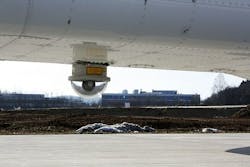Secure quantum code transmitted by mobile aircraft to the ground for first time
Munich, Germany--A team led by Ludwig-Maximilians-Universität München (LMU) physicist Harald Weinfurter and Sebastian Nauerth at the Physics Faculty at LMU Munich in collaboration with the German Center for Aeronautics and Space Research (DLR), has succeeded in optically transmitting quantum information between a ground station and a plane in flight; see the article in Nature Photonics at http://www.nature.com/nphoton/journal/vaop/ncurrent/abs/nphoton.2013.46.html. This is the first demonstration of free space optical (FSO) (http://www.laserfocusworld.com/articles/2010/11/photonics-applied-free-space-communications-sophisticated-optical-system-extend-reach-of-free-space-communications.html) quantum cryptography transmission using a mobile transmitter.
The quantum channel was integrated into DLR's laser-based, wireless communications system, (http://www.laserfocusworld.com/articles/2011/04/free-space-optical-communication-n-slit-interferometer-extends-secure-free-space-communications-to-527-m.html) allowing DLR's expertise and experience with the system to be utilized in the realization of the experiment.
"This demonstrates that quantum cryptography can be implemented as an extension to existing systems," says LMU's Sebastian Nauerth. In the experiment, single photons were sent from the aircraft to the receiver on the ground. The challenge was to ensure that the photons could be precisely directed at the telescope on the ground in spite of the impact of mechanical vibrations and air turbulence. "With the aid of rapidly movable mirrors, a targeting precision of less than 3 m over a distance of 20 km was achieved," reports Florian Moll, project leader at the DLR's Institute for Communication and Navigation. With this level of accuracy, William Tell could have hit the apple on his son’s head even from a distance of 500 m.
Unlike communication based on classical bits, quantum cryptography uses the quantum states of single light quanta (photons) for the exchange of data. Heisenberg's uncertainty principle limits the precision with which the position and momentum of a quantum particle can be determined simultaneously, but can also be exploited for secure information transfer. Like its classical counterpart, quantum cryptography requires a shared key with which the parties encode and decode messages. However, quantum mechanical phenomena guarantee the security of quantum key distribution. Because quantum states are fragile, interception of the key by an eavesdropper will alter the behavior properties of the particles, and thus becomes detectable.
This encrypting strategy is already being used by some government agencies and banks. Data are sent either along glass-fiber cables or through the atmosphere. However, optical key distribution via these channels is limited to distances of less than 200 km, due to signal losses along the way. In 2007, LMU physicist Harald Weinfurter and his group successfully transmitted a key over 144 km of free space between ground stations on the islands of Tenerife and La Palma. Distribution of such keys via satellite networks would make secure data transmission possible on a global scale.
With respect to the rate of signal loss and the effects of air turbulence, the conditions encountered during the experiment were comparable to those expected for transmission via satellite. The same holds for the angular velocity of the aircraft. The success of the experiment therefore represents an important step towards secure satellite-based global communication.
SOURCE: Ludwig-Maximilians-Universität München (LMU); http://www.en.uni-muenchen.de/news/newsarchiv/2013/f-m-26-13.html

Gail Overton | Senior Editor (2004-2020)
Gail has more than 30 years of engineering, marketing, product management, and editorial experience in the photonics and optical communications industry. Before joining the staff at Laser Focus World in 2004, she held many product management and product marketing roles in the fiber-optics industry, most notably at Hughes (El Segundo, CA), GTE Labs (Waltham, MA), Corning (Corning, NY), Photon Kinetics (Beaverton, OR), and Newport Corporation (Irvine, CA). During her marketing career, Gail published articles in WDM Solutions and Sensors magazine and traveled internationally to conduct product and sales training. Gail received her BS degree in physics, with an emphasis in optics, from San Diego State University in San Diego, CA in May 1986.
